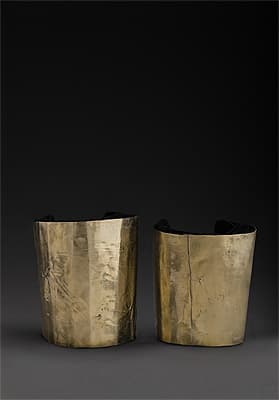
INCA culture 1400 – 1533 AD
Set of bracelets 1400-1533 AD gold10.0 (h) x 5.5 (w) cm Museo Oro del Perú, Lima Photograph: Daniel Giannoni
Inca goldsmiths are hardly celebrated today, as so little of their work remains. Were there hundreds, even thousands of items such as these, made of rolled and polished gold, then looted by the Spanish conquistadors? The form is simple, and probably all but universal; the Sicán calf guards (cat. 122) have almost the same shape, which occurs when sheets of rolled gold are cut to curl around a limb. The Sapa Inca, as divine ruler and son of the Sun God, had the unique right to distribute gold, which was associated with the sun and the colour yellow. Only the governing elite had the right to wear it. So it is possible bodily decorations like this were made both to be worn for ceremonies and as part of the amazing burial goods that accompanied the dead.
As the two bracelets differ slightly in size, they are not a matching pair in the usual sense of the term. Inca practice usually demanded pairing or doubling—gold and silver miniature figures, for example (cat. 195)—but there was often a slight difference in size. The reason is obscured by time. The armlets would probably have been part of an ostentatious parure, or set of jewellery, which was eventually attached to the corpse of a noble or powerful individual. Headdresses, ear spools, nose ornaments, necklaces, pectorals, clothing decorations, bracelets and anklets: all or some of these would be made of gold if the person was powerful enough to warrant it. The elements and patterning varied with geography and culture, but all the dead would be accompanied by textiles and grave goods.
Christine Dixon
Inca goldsmiths are hardly celebrated today, as so little of their work remains. Were there hundreds, even thousands of items such as these, made of rolled and polished gold, then looted by the Spanish conquistadors? The form is simple, and probably all but universal; the Sicán calf guards (cat. 122) have almost the same shape, which occurs when sheets of rolled gold are cut to curl around a limb. The Sapa Inca, as divine ruler and son of the Sun God, had the unique right to distribute gold, which was associated with the sun and the colour yellow. Only the governing elite had the right to wear it. So it is possible bodily decorations like this were made both to be worn for ceremonies and as part of the amazing burial goods that accompanied the dead.
As the two bracelets differ slightly in size, they are not a matching pair in the usual sense of the term. Inca practice usually demanded pairing or doubling—gold and silver miniature figures, for example (cat. 195)—but there was often a slight difference in size. The reason is obscured by time. The armlets would probably have been part of an ostentatious parure, or set of jewellery, which was eventually attached to the corpse of a noble or powerful individual. Headdresses, ear spools, nose ornaments, necklaces, pectorals, clothing decorations, bracelets and anklets: all or some of these would be made of gold if the person was powerful enough to warrant it. The elements and patterning varied with geography and culture, but all the dead would be accompanied by textiles and grave goods.
Christine Dixon
Inca goldsmiths are hardly celebrated today, as so little of their work remains. Were there hundreds, even thousands of items such as these, made of rolled and polished gold, then looted by the Spanish conquistadors? The form is simple, and probably all but universal; the Sicán calf guards (cat. 122) have almost the same shape, which occurs when sheets of rolled gold are cut to curl around a limb. The Sapa Inca, as divine ruler and son of the Sun God, had the unique right to distribute gold, which was associated with the sun and the colour yellow. Only the governing elite had the right to wear it. So it is possible bodily decorations like this were made both to be worn for ceremonies and as part of the amazing burial goods that accompanied the dead.
As the two bracelets differ slightly in size, they are not a matching pair in the usual sense of the term. Inca practice usually demanded pairing or doubling—gold and silver miniature figures, for example (cat. 195)—but there was often a slight difference in size. The reason is obscured by time. The armlets would probably have been part of an ostentatious parure, or set of jewellery, which was eventually attached to the corpse of a noble or powerful individual. Headdresses, ear spools, nose ornaments, necklaces, pectorals, clothing decorations, bracelets and anklets: all or some of these would be made of gold if the person was powerful enough to warrant it. The elements and patterning varied with geography and culture, but all the dead would be accompanied by textiles and grave goods.
Christine Dixon

